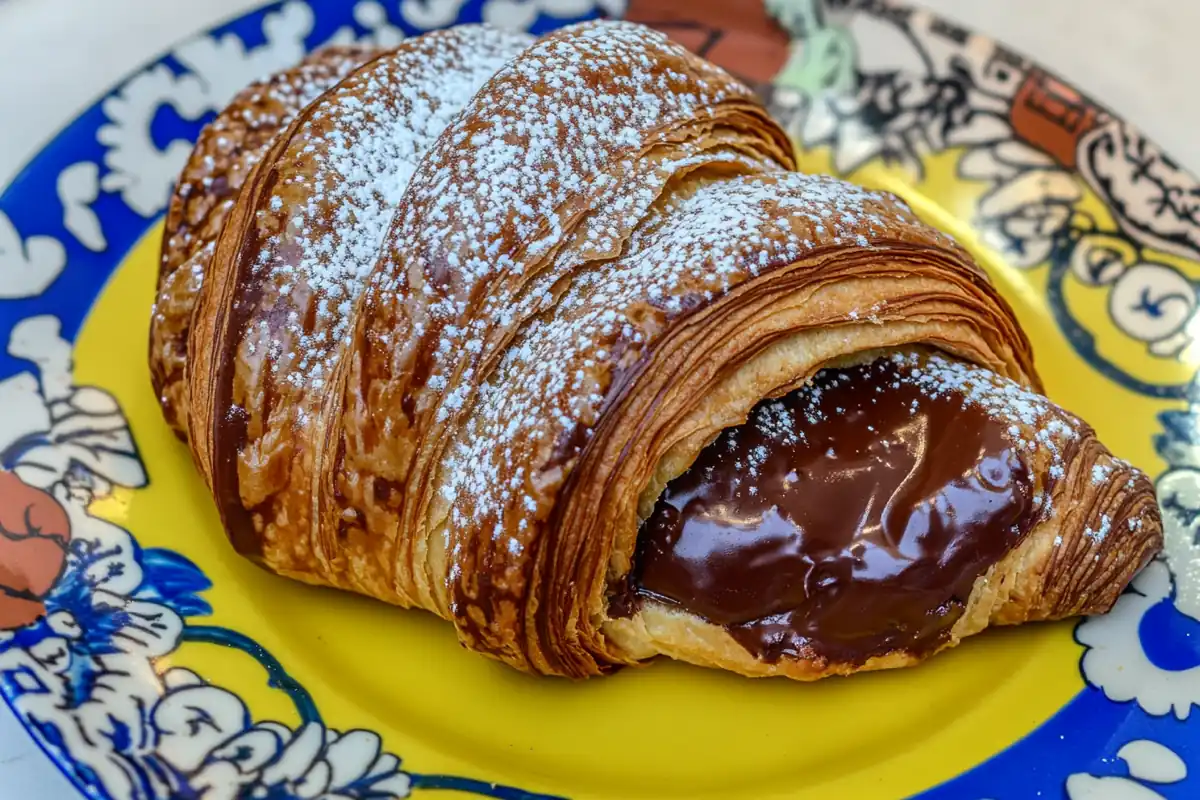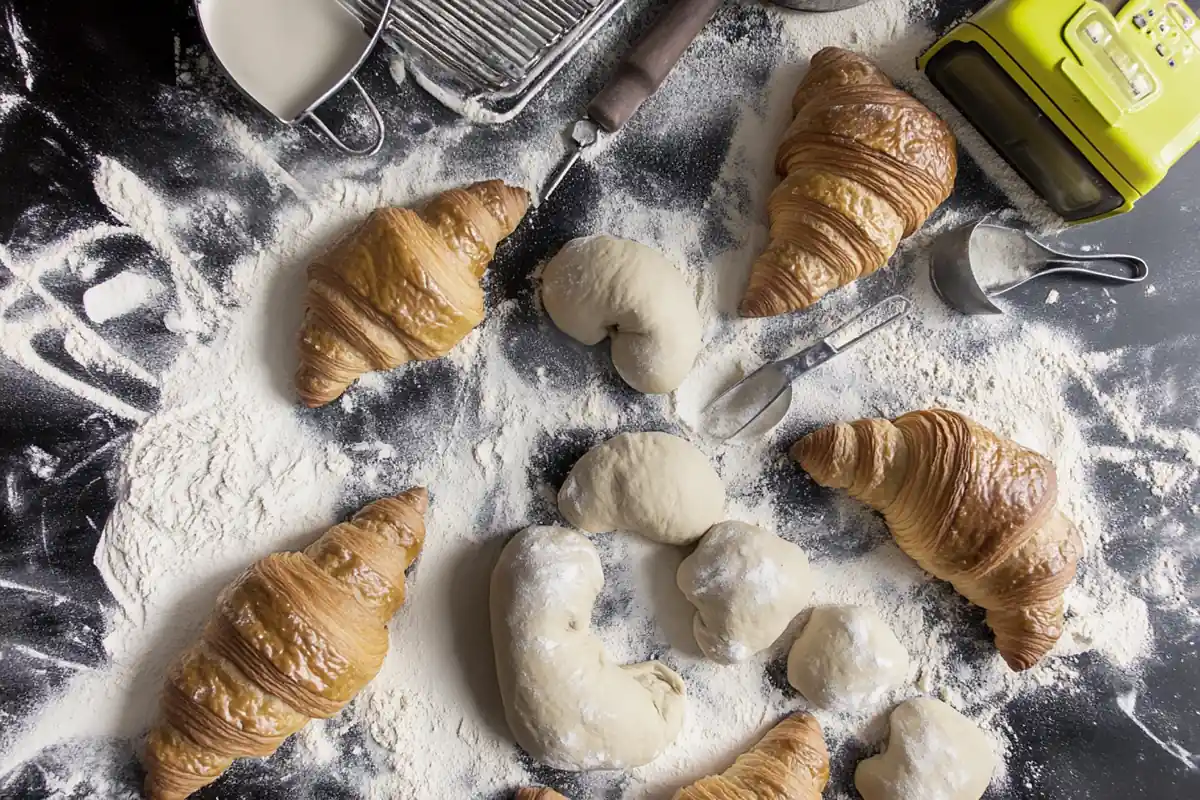Croissants are not just pastries; they are a delightful experience that many people cherish. The flaky, buttery texture and the warm, comforting aroma make croissants a favorite breakfast item and a popular snack. In this guide, we will explore everything there is to know about croissants, from their definition and types to their fascinating origin. We’ll also dive into the ingredients and techniques needed to create these delicious treats at home.
Table of Contents
What are Croissants?
Croissants are a type of French pastry known for their crescent shape and flaky layers. The name “croissant” comes from the French word for “crescent,” which describes its shape. Traditionally made with a dough that contains yeast, flour, butter, and salt, croissants are laminated, meaning that layers of butter are folded into the dough to create a rich texture.
Definition of Croissants
At their core, croissants are made from a dough that undergoes a process called lamination. This involves folding and rolling the dough with butter several times to create many thin layers. When baked, these layers puff up beautifully, resulting in a light and airy pastry.
Types of Croissants
Croissants come in various forms. Some popular types include:
- Classic Croissant: The original version, buttery and flaky.
- Chocolate Croissant: Filled with rich chocolate, perfect for sweet lovers.
- Almond Croissant: Topped with almond paste and sliced almonds for a nutty flavor.
- Ham and Cheese Croissant: A savory option filled with ham and cheese.
Each type offers a unique flavor profile, catering to different tastes. For those who want to explore more delicious breakfast options, check out tips for delicious sweet breakfast recipes.
The Origin of Croissants: A Historical Journey
The origin of croissants is a blend of history and culinary evolution. Many believe that croissants were inspired by the Austrian kipferl, a crescent-shaped pastry. However, they have evolved significantly in French culture.
Croissant Origin: From Austria to France
The story goes back to the 13th century when the kipferl made its appearance in Austria. It wasn’t until the 19th century that the pastry made its way to France. Legend has it that after the victory over the Ottomans in 1683, Viennese bakers celebrated by creating this crescent-shaped pastry.
The Role of Viennoiserie
Viennoiserie is a term that refers to baked goods made from a yeast-leavened dough. Croissants fall under this category, showcasing the French mastery of pastry-making. As the popularity of Viennoiserie grew, so did the demand for croissants, leading to their iconic status in French cuisine.
The Evolution of the Croissant in French Cuisine
By the 20th century, croissants had become a staple in French bakeries. Their unique texture and flavor made them a favorite among locals and tourists alike. Today, croissants are enjoyed worldwide, often paired with coffee during breakfast or as a midday snack.
The Art of Making Croissants: Ingredients and Techniques
Creating the perfect croissant requires precision, patience, and the right ingredients. Understanding the essential croissant ingredients is crucial for achieving that flaky texture.
Essential Croissant Ingredients
The basic ingredients for making croissants include:
- Flour: All-purpose flour is commonly used, providing the right structure.
- Butter: High-quality butter is crucial for rich flavor and flaky layers.
- Yeast: Helps the dough rise and gives it a light texture.
- Water and Salt: Essential for hydrating the dough and enhancing flavor.
Flour, Butter, Yeast, and Water
Using the right type of flour and butter is essential. Bread flour is often recommended for its higher protein content, which contributes to a better rise. The butter should be at a cold temperature, making it easier to work into the dough without melting.
The Importance of Temperature and Technique
Maintaining a cool environment is vital when making croissants. Warmer temperatures can cause the butter to melt, ruining the lamination process. Therefore, it’s essential to work quickly and keep everything chilled.

Croissant with Chocolate: A Delicious Twist
One of the most beloved variations of the classic croissant is the chocolate croissant, also known as “pains au chocolat.” This delightful pastry has captured the hearts and taste buds of chocolate lovers everywhere.
The Rise of Chocolate Croissants
Chocolate croissants have become a staple in bakeries around the world. Their combination of flaky pastry and rich chocolate creates a satisfying treat that is perfect any time of the day. The indulgence of biting into a warm croissant filled with melted chocolate is hard to resist.
Popular Variations of Croissant with Chocolate
While the traditional chocolate croissant features dark chocolate, variations have emerged to cater to different tastes. Some popular options include:
- Milk Chocolate Croissant: A sweeter alternative for those who prefer a milder chocolate flavor.
- Nutella Croissant: Filled with the famous hazelnut spread, offering a creamy and rich experience.
- White Chocolate Croissant: For those who enjoy a sweeter, creamier chocolate flavor.
These variations allow bakers to experiment with flavors, making chocolate croissants a versatile option.
How to Make a Chocolate Croissant at Home
Making chocolate croissants at home is easier than you might think! Here’s a simple recipe to get you started:
- Prepare the Dough: Follow a basic croissant dough recipe.
- Add the Chocolate: Once the dough is rolled out, place pieces of chocolate or chocolate spread in the center.
- Shape the Croissant: Roll the dough around the chocolate, sealing the edges.
- Bake: Follow the baking instructions for croissants until golden brown.
For more ideas on delicious breakfast recipes, consider looking into sweet breakfast recipes that can complement your croissant-making endeavors.
Nutritional Aspects of Croissants
When it comes to nutrition, croissants often raise questions about their health benefits compared to other baked goods. Understanding their nutritional profile is essential for making informed choices.
Are Croissants Healthier than Bread?
Many people wonder whether croissants are healthier than regular bread. The answer can vary based on individual dietary needs and preferences.
Comparing Nutritional Values
- Calories: Croissants are generally higher in calories than standard bread due to their butter content.
- Fat Content: The fat content in croissants is significantly higher, which can be both good and bad, depending on your dietary goals.
- Carbohydrates: Both croissants and bread provide carbohydrates, but croissants might have a higher glycemic index.
Understanding these differences can help you decide what fits your dietary needs best.
Are Croissants Healthy?
The healthiness of croissants largely depends on the ingredients and how often you indulge.
Factors Influencing Healthiness
- Portion Size: Enjoying croissants in moderation can fit into a balanced diet.
- Ingredients: Using whole grain flour and less butter can increase their nutritional value.
- Personal Dietary Needs: If you have specific health concerns, it’s essential to consider how croissants fit into your overall diet.
While croissants can be a delicious treat, they should be enjoyed in moderation, especially when considering overall health.
Pairing Croissants: Best Accompaniments
Croissants are delightful on their own, but they can be even better when paired with the right accompaniments. Discovering what pairs well with croissants can elevate your dining experience.
Beverages That Complement Croissants
The right beverage can enhance the enjoyment of your croissant. Here are some popular choices:
- Coffee: A classic pairing, the bitterness of coffee balances the buttery sweetness of croissants.
- Tea: Many enjoy pairing croissants with various teas, including Earl Grey or chamomile.
- Hot Chocolate: For a sweet treat, a warm cup of hot chocolate is a delightful match.
These beverages can bring out the flavors in croissants, making for a satisfying meal.
Coffee and Tea Pairings
When enjoying croissants, consider the type of coffee or tea you choose. For example, a bold espresso can contrast beautifully with a buttery croissant, while a light herbal tea can create a refreshing balance. Explore more about what pairs well in this coffee and tea pairing guide.

The Global Love for Croissants
Croissants have transcended their French origins to become a beloved pastry worldwide. Their flaky texture and rich flavor have made them a staple in many cultures, each adding its unique twist.
Croissants Around the World
Across different countries, croissants have taken on various forms and fillings. Here are some notable adaptations:
- Hong Kong’s Egg Tart: While not a croissant, the flaky pastry shares similarities with its buttery layers.
- Argentinian Medialuna: This crescent-shaped pastry often has a sweeter dough, making it a delightful breakfast option.
- Japanese Croissant: Often filled with a variety of creams or custards, these croissants showcase local flavors.
These variations demonstrate how versatile the croissant can be, adapting to local tastes and ingredients.
Variations in Different Cultures
In each culture, croissants have evolved to reflect local preferences. For example, in Italy, you might find croissants filled with pastry cream, while in Brazil, they may be served with cheese. This global love for croissants showcases their universal appeal. To learn more about exploring international flavors, check out this guide on what to eat when nothing sounds good.
The Popularity of Croissants in Bakeries
Today, croissants are a must-have in bakeries around the world. Many artisanal bakeries focus on perfecting the croissant, using high-quality ingredients and traditional techniques. This dedication has led to a renaissance in croissant-making, with shops often featuring long lines of eager customers.
The Future of Croissants: Trends and Innovations
As food trends evolve, so do the ways we enjoy croissants. The future of this beloved pastry looks promising, with innovative twists and health-conscious alternatives gaining popularity.
Vegan and Gluten-Free Croissant Options
With the rise of plant-based diets, vegan and gluten-free croissants are becoming more common. Many bakeries now offer options that cater to these dietary needs, allowing more people to enjoy this delightful treat.
The Impact of Modern Baking Techniques
Advancements in baking techniques and technology are also influencing croissant production. For instance, using high-quality vegan butter can yield results similar to traditional butter, making it easier to create delicious pastries without animal products. These innovations will only continue to enhance the croissant experience for everyone.
In conclusion, the love for croissants is truly global. From their rich history to their diverse adaptations, croissants remain a staple in many cultures. Whether enjoyed plain, filled with chocolate, or paired with a warm beverage, they are a timeless treat that brings joy to many.

Croissant-Making Workshops: Learning the Craft
For those looking to dive deeper into the art of making croissants, attending a croissant-making workshop can be an enriching experience. These workshops often provide hands-on training, allowing participants to create their own pastries from scratch.
What to Expect in a Croissant Workshop
In a typical croissant-making workshop, you can expect to learn about the entire process, from preparing the dough to baking the final product. Experienced instructors guide participants through each step, ensuring everyone understands the techniques involved.
Tips for Beginners
- Start Simple: If you’re new to baking, begin with a basic croissant recipe before experimenting with more complex variations.
- Pay Attention to Temperature: Keep your ingredients and workspace cool to maintain the integrity of the dough.
- Practice Patience: Laminating dough takes time, and the more you practice, the better your results will be.
By following these tips, beginners can build confidence in their baking skills and enjoy their culinary journey.
Famous Croissant Bakeries to Visit
If you want to experience exceptional croissants, consider visiting some renowned bakeries. Many cities boast bakeries that are famous for their croissants. For example, in Paris, you might explore:
- Du Pain et des Idées: Celebrated for its buttery, flaky pastries.
- La Parisienne: Known for its traditional French croissants and innovative flavors.
These bakeries not only offer delicious croissants but also provide insight into the craft of pastry-making.
Additional Resources on Croissants
For those eager to learn more about croissants, there are plenty of resources available. Here are some recommendations:
Recommended Books and Cookbooks
- “The Art of French Pastry” by Jacquy Pfeiffer and Martha Rose Shulman: A comprehensive guide to mastering French pastries, including croissants.
- “Pastry School: 101 Techniques” by Le Cordon Bleu: A fantastic resource for budding pastry chefs.
Online Tutorials and Videos
Many online platforms offer free tutorials and videos that can help you grasp the techniques of croissant making. YouTube is a great place to start, with countless baking enthusiasts sharing their tips and tricks.
Blogs and Forums for Croissant Enthusiasts
Joining online baking communities can provide support and inspiration. Consider exploring blogs dedicated to pastry-making or forums where you can share experiences and ask questions.
With this guide, you are now equipped to explore the world of croissants, from making your own at home to discovering their cultural significance. So, grab some ingredients, find a recipe, and start your croissant journey today!
Conclusion: The Timeless Appeal of Croissants
Croissants have a timeless appeal that continues to captivate people around the world. Their flaky layers and rich flavor make them a beloved choice for breakfast, snacks, or indulgent treats. As we’ve explored, the journey of croissants from their origins to their global adaptations showcases their versatility and enduring popularity.
Why Croissants Remain a Favorite
The secret to the croissant’s lasting appeal lies in its combination of simple ingredients and complex techniques. Each bite offers a delightful blend of textures and flavors that satisfies both sweet and savory cravings. Whether enjoyed fresh out of the oven or filled with chocolate, croissants hold a special place in many hearts.
The Cultural Significance of Croissants
Croissants are more than just a pastry; they symbolize the joy of shared meals and culinary artistry. They bring people together, whether at a café in Paris or in your own kitchen. Their presence in various cultures highlights the universal love for good food and the traditions that shape it.
FAQ
As croissants continue to capture the hearts of food lovers, several common questions arise. Here are some frequently asked questions that can help clarify some curiosities about this beloved pastry.
What Does “Croissant” Literally Mean?
The word “croissant” translates to “crescent” in French. This name is fitting, as the pastry is shaped like a crescent moon. The shape has become an iconic representation of this delightful treat.
Are Croissants French or German?
While croissants are commonly associated with French cuisine, their origins can be traced back to Austria. The concept of the crescent-shaped pastry, known as kipferl, predates the modern croissant. It was French chefs who perfected the recipe and popularized it in France.
Are Croissants Healthy: Yes or No?
The healthiness of croissants can depend on several factors, such as ingredients, portion size, and frequency of consumption. While they are higher in calories and fat than standard bread, enjoying them in moderation can fit into a balanced diet.
How to Store Croissants for Freshness?
To keep croissants fresh, store them in an airtight container at room temperature. If you need to keep them longer, freezing is an option. Wrap them tightly in plastic wrap and place them in a freezer-safe bag. When ready to eat, simply reheat in the oven for a few minutes to restore their flaky texture.




